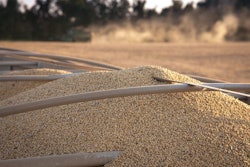
The USDA has released itsWorld Agricultural Supply and Demand Estimates(WASDE) for May 2021. The May report includes USDA’s first balance sheet outlooks for the 2021/22 crop year.
WHEAT:The initial outlook for 2021/22 U.S. wheat is for smaller supplies, higher domestic use, lower exports, and reduced stocks. Supplies are projected down 3 percent from 2020/21 on lower carry-in stocks offsetting higher production and imports. All wheat production is projected at 1,872 million bushels, up 3 percent from last year on higher harvested acreage and yields. The all wheat yield is projected at 50.0 bushels per acre, up 0.3 bushels.
The first 2021 NASS survey-based winter wheat production forecast of 1,283 million bushels is up 10 percent from 2020, on increased Hard Red Winter and Soft Red Winter production more than offsetting lower White Winter production.
Total 2021/22 domestic use is projected 6 percent higher on higher feed and residual and food use. A reduced wheat-corn price spread is expected to raise wheat feeding in the June-August quarter with annual feed and residual use projected at 170 million bushels, the highest since 2013/14. Food use is projected modestly higher at 963 million bushels, up 3 million from a revised 2020/21 estimate of 960 million.
Exports are projected at 900 million bushels, down 65 million from the revised 2020/21 exports. Several major exporters are projected to have larger supplies in 2021/22 and relatively high U.S. prices are expected to reduce U.S. competitiveness. Projected 2021/22 ending stocks are 11 percent lower than last year at 774 million bushels, the lowest level in seven years.
The projected 2021/22 season-average farm price is $6.50 per bushel, up $1.45 from last year’s revised price on reduced stocks and significantly higher U.S. corn prices. The initial global wheat outlook for 2021/22 is for larger supplies, higher consumption, increased trade, and marginally higher stocks. Supplies are projected to increase 8.1 million tons to 1,083.7 million with production projected at a record 789.0 million tons.
更高的生产阿根廷、欧盟、英国、Morocco, Ukraine, and the United States is expected to more than offset reductions for Australia and Canada. Russia’s production of 85.0 million tons is similar to last year’s record on increased winter wheat area. Projected 2021/22 world consumption is raised 7.8 million tons to a record 788.7 million, primarily on higher food, seed, and industrial (FSI) use, continuing a long-term uptrend. Wheat feed and residual use is projected up relatively less than FSI as increases in the EU, UK, Russia, and the United States are partially offset by decreased feed use for China, Canada and Australia.
Projected 2021/22 global trade is a record 202.4 million tons, up 2.8 million from last year on increased exportable supplies. Imports are projected to rise, primarily on increased demand from Algeria, Indonesia, the EU, and Middle East region. China’s imports are projected slightly lower at 10.0 million tons but remain large with stocks continuing to decline despite higher production. Imports are also projected lower for Pakistan and Morocco on increased supplies.
Russia is projected as the leading 2021/22 wheat exporter at 40.0 million tons. Argentina, the EU, and Ukraine exports are also projected higher while Australia, Canada, and the United States are lower.
Projected 2021/22 world ending stocks are modestly higher at 295.0 million tons with China accounting for 48 percent of the total.
COARSE GRAINS:The U.S. feed-grain outlook for 2021/22 is for greater production and domestic use, lower exports, and increased ending stocks. The corn crop is projected at 15.0 billion bushels, up from last year on higher area and a return to trend yield. The yield projection of 179.5 bushels per acre is based on a weather-adjusted trend assuming normal planting progress and summer growing season weather, estimated using the 1988-2020 time period. With beginning stocks that are down sharply from a year ago, total corn supplies are forecast to increase modestly to 16.3 billion bushels.
Total U.S. corn use in 2021/22 is forecast to decline relative to a year ago as greater domestic use is more than offset by lower exports. Food, seed, and industrial (FSI) use is projected to rise 220 million bushels to 6.6 billion. Corn used for ethanol is projected to increase based on expectations of higher U.S. motor gasoline consumption.
Sorghum FSI is unchanged from a year ago as expectations of robust sorghum exports to China limit available domestic supplies. Corn feed and residual use is unchanged, as a larger crop is offset by increased corn used for ethanol and higher expected season-average farm prices received by producers.
U.S. corn exports are forecast to decline 325 million bushels in 2021/22. Unfavorable production prospects are forecast to limit exports out of Argentina and Brazil during 2020/21 (local marketing years beginning March 2021 and ending February 2022), supporting U.S. exports during the first half of 2021/22. However, a 335-million-bushel increase in the combined corn exports for Ukraine and Russia in 2021/22 is expected to increase competition for the United States, reducing the forecast U.S. share of global corn trade from a year ago.
With total U.S. corn supply rising and use declining, 2021/22 U.S. ending stocks are up 250 million bushels from last year. Stocks relative to use at 10.2 percent would be above a year ago but still below the average seen during 2016/17 to 2019/20. The season-average corn price received by producers in 2021/22 is projected at $5.70 per bushel, up $1.35 from a year ago when much of the crop was marketed at lower prices.
全球前景粗粒是2021/22record production and use, and larger ending stocks. World corn production is forecast record high, with the largest increases for the United States, Brazil, China, Ukraine, and Argentina.
Global corn use is expected to grow 3 percent, with foreign consumption up 3 percent. Global corn imports are projected to increase 3 percent. Notable increases in corn imports include the EU, Turkey, Iran, Japan, and Mexico. Global corn ending stocks are up 3 percent from a year ago, with expected increases for the United States and foreign countries. Excluding China, corn ending stocks are up 10 percent relative to a year ago.
For China, total coarse grain imports are forecast at 46.3 million tons, up 3.1 million from 2020/21 and if realized would be record high. Expectations are for continued relatively high corn and other energy feedstuff prices in China, despite an increase in corn production. Among the individual coarse grains, corn imports are forecast at 26.0 million tons, barley at 10.0 million, and sorghum at 10.0 million.
OILSEEDS:The 2021/22 outlook for U.S. soybeans is for lower supplies, lower exports, higher crush and higher ending stocks compared with 2020/21. The soybean crop is projected at 4.4 billion bushels, up 270 million from last year on increased harvested area and trend yields.
With lower beginning stocks, soybean supplies are projected down 3 percent from 2020/21. Total U.S. oilseed production for 2021/22 is forecast at 130.3 million tons, up 7.9 million from 2020/21.
U.S. soybean crush for 2021/22 is projected at 2.2 billion bushels, up 35 million from the 2020/21 forecast, reflecting favorable crush margins.
豆油预计持有更高的份额the crush value as prices are buoyed by increased use of soybean oil as a feedstock in an expanding renewable diesel industry. The soybean oil balance sheet line titled “Biodiesel” is replaced by “Biofuel” this month.
The biofuel line includes soybean oil used for both biodiesel and renewable fuels as reported in the U.S. Energy Information Administration’s Monthly Biofuels Capacity and Feedstocks Update, which replaced the Monthly Biodiesel Production Report. Prior year estimates for renewable fuel are based on data from the U.S. Environmental Protection Agency, the California Air Resource Board, and capacity information from industry.
U.S. soybean exports are forecast at 2.1 billion bushels, down 205 million from 2020/21. With lower soybean supplies and higher crush, the U.S. export share of global soybean trade is expected to decline to 33 percent from 36 percent in 2020/21.
U.S. soybean ending stocks for 2021/22 are projected at 140 million bushels, up 20 million from the 2020/21 forecast. With prices for fall delivery above $14.00 per bushel in some locations, the 2021/22 U.S. season-average soybean price is projected at $13.85 per bushel, up $2.60 from 2020/21.
Soybean meal prices are forecast at $400 per short ton, down $5.00 from the revised forecast for 2020/21. Soybean oil prices are forecast at 65.0 cents per pound, up 10 cents from the revised 2020/21 forecast. Global oilseed supplies for 2021/22 are projected to increase 3 percent from 2020/21 to 732.4 million tons, with higher prices incentivizing an expansion of oilseed area and higher sunflowerseed production after the prior season’s yield-related declines.
Global soybean production is forecast up 22.6 million tons to 385.5 million. Brazil’s crop is forecast at a record 144.0 million tons while Argentina’s crop rises 5.0 million tons to 52 million. Global production of high-oil content seeds (sunflowerseed and rapeseed) is projected up 6 percent from 2020/21 on a recovery of sunflowerseed production for Ukraine, Russia, and the EU and increased canola for Canada.
Global soybean exports are expected to increase 1 percent to 172.9 million tons. The U.S. share of global exports is forecast to decline while Brazil’s share increases from 50 percent in 2020/21 to 54 percent in 2021/22. China’s imports are forecast to increase 3 million tons to 103 million. Global soybean ending stocks are projected at 91.1 million tons, up 4.6 million, with most of the increase in China and Brazil.
Global vegetable oil consumption for 2021/22 is projected at 213.2 million tons, up 3.0 percent, led by increases for China and the United States. Global vegetable oil ending stocks are projected at 22.4 million tons, down 3 percent from 2020/21 and the lowest in 11 years.





















